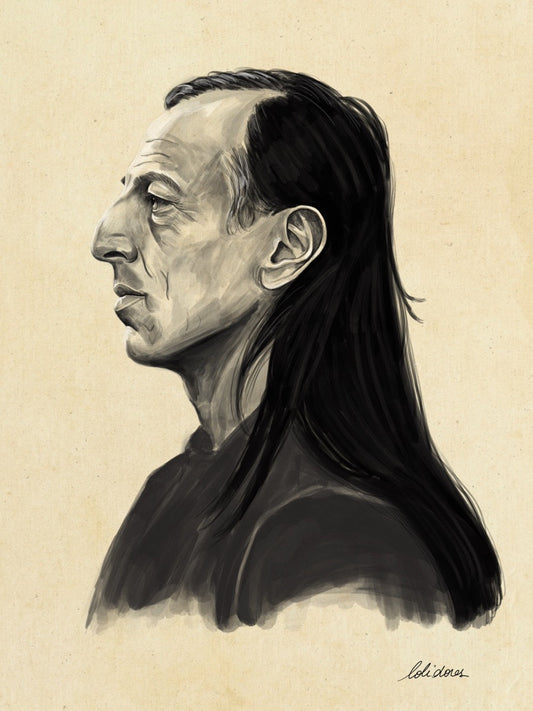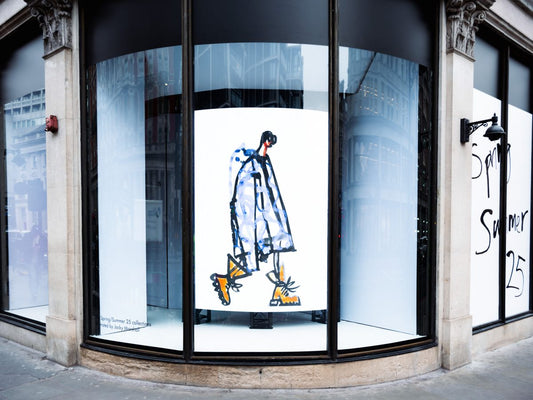
Lolita Rodrigo Paints Fashion’s Disruptors for FIDA
Share
What does fashion genius look like? If you're Lolita Rodrigo, it's not just about clothes - it's about energy, mood, rebellion, and quiet intensity. That’s exactly what the acclaimed portrait artist brings to her latest commission for FIDA: a series of raw, intimate portraits capturing the biggest names rewriting the rules of modern fashion.
In this special collaboration, Rodrigo turns her focus to ten designers who have not only defined trends, but completely reshaped the cultural landscape: Jonathan Anderson, Kim Jones, Rick Owens, Simon Porte Jacquemus, Stella McCartney, Erdem, Giorgio Armani, Haider Ackermann, Paul Smith, and Raf Simons.
No big deal.
Rodrigo’s portraits don’t just show faces - they radiate presence. Rick Owens looks like he just emerged from a shadowy post-apocalyptic dream (naturally), while Stella McCartney is all sharp serenity, echoing her eco-luxe ethos. Jonathan Anderson, with his gender-fluid genius, is rendered with a sense of thoughtful curiosity, and Kim Jones - the man with one foot in streetwear and the other in couture - exudes calculated cool.
Each piece feels like a personal moment frozen in time: Haider Ackermann in cinematic stillness, Jacquemus all sun-drenched charm, Erdem dreamy and detailed. Even Giorgio Armani, the godfather of quiet luxury, is given a fresh, human edge - a reminder that legacy isn’t stiff, it evolves.
Rodrigo’s signature style - somewhere between raw sketch and finished masterpiece - perfectly fits this lineup. These are designers who embrace contradiction: structure and chaos, softness and strength. She gets that. Her work doesn’t just illustrate; it reveals.
FIDA’s decision to commission these portraits isn’t just about celebration - it’s about documenting a moment. A moment when fashion is more about identity, message, and meaning than ever before. A moment when the designers we follow aren’t just makers - they’re storytellers, rule-breakers, quiet radicals.
The portrait series will drop later this year, complete with a dedicated exhibition that fuses art, fashion, and the faces driving the culture forward.
Until then? Consider this your moodboard for creative ambition.

Jonathan Anderson
Jonathan Anderson is fashion’s ultimate shape-shifter — a designer who thrives in contradictions. As the creative mind behind both JW Anderson and LOEWE, he navigates between high-concept art and wearable innovation with surreal ease. Whether he’s sculpting puffball silhouettes or reinventing the humble cardigan, there’s always a tension — between masculinity and femininity, structure and absurdity, beauty and wit.
His collections feel like gallery exhibitions with a pulse. Anderson isn’t just interested in trends; he wants to provoke, play, and make people feel something. He collaborates with artists, challenges norms, and refuses to stay in a creative comfort zone. If fashion is about storytelling, Anderson is writing in a language entirely his own — and it’s one the industry can’t stop trying to decode.

Kim Jones
Kim Jones is the cultural conduit — the guy who made streetwear luxurious and luxury streetwise. Now the powerhouse behind Dior Men and Fendi, Jones bridges the worlds of tailoring, youth culture, and high-end experimentation. He doesn’t just design collections — he curates worlds, often enlisting artists and creatives across disciplines to bring his vision to life.
From his early days at Dunhill to launching game-changing collaborations with the likes of Supreme, Jones has built a career on knowing exactly what the culture wants before it asks. He’s a designer of the moment, for the moment — delivering hype and heritage in equal measure, and making sure couture never gets too comfortable.

Rick Owens
Rick Owens doesn’t design clothes — he crafts mythologies. The self-proclaimed “Lord of Darkness” has built a universe that’s part apocalyptic fantasy, part performance art. His aesthetic is brutalist, sculptural, and radical, yet deeply human. In Rick’s world, draping becomes armor, and leather becomes language.
His cult-like following isn’t just about the look — it’s about the ethos. Owens challenges beauty standards, embraces gender fluidity, and leans into the weird, the raw, and the uncomfortable. Whether staging shows in ancient ruins or sending models down runways in sky-high platform boots, he proves fashion can be both deeply intellectual and unapologetically intense.

Simon Porte Jacquemus
Simon Porte Jacquemus is the sun-drenched dreamer of fashion. Hailing from the south of France, he infuses his label Jacquemus with Mediterranean warmth, playful silhouettes, and just the right amount of chaos. Think tiny bags, gigantic hats, and asymmetry served with a glass of rosé and a side of mischief.
But don’t let the Instagram-ready aesthetic fool you — Jacquemus has vision and range. He’s taken his brand from cult favourite to global force while staying fiercely independent and emotionally honest. His shows — set in lavender fields or wheat plains — feel like love letters to nature, nostalgia, and the simplicity of a good idea done beautifully.

Stella McCartney
Stella McCartney didn’t just step into fashion — she changed the rules. A trailblazer in sustainable luxury, she’s made it her mission to prove that ethics and elegance can coexist. No leather, no fur, no compromises — just razor-sharp tailoring and effortless femininity wrapped in a future-facing philosophy.
Her namesake brand is sleek but soft, polished but never overdone — and always guided by purpose. Beyond the runway, McCartney is a vocal advocate for climate action and animal rights, using her platform to push the industry forward. She’s not just designing for today — she’s imagining what fashion should be tomorrow.

Erdem Moralıoğlu
Erdem crafts stories in silk and lace. His designs are a study in contrasts: delicate yet powerful, nostalgic yet modern. Every collection feels like stepping into a secret garden where historical muses and cinematic drama collide. Think high collars, floral embroidery, and silhouettes that whisper with emotion.
Behind the softness is precision. With a background in history and costume, Erdem weaves intellectual depth into his collections without losing their romance. Worn by royalty and rebels alike, his clothes evoke a kind of timelessness that refuses to feel old-fashioned. In a world obsessed with speed, Erdem reminds us of the beauty of pause.

Giorgio Armani
Giorgio Armani is the architect of elegance. He redefined tailoring in the 1980s, stripping away excess and sharpness to create soft, flowing suits that reshaped power dressing forever. Armani’s vision is minimalist, but never minimal — it’s about control, confidence, and the quiet art of refinement.
Decades later, his influence is everywhere. From red carpets to boardrooms, the Armani signature — sleek, fluid, and impeccably composed — remains a gold standard. He’s built an empire without chasing trends, proving that true style doesn’t shout. It simply walks into a room and owns it.

Haider Ackermann
Haider Ackermann is fashion’s poet. His collections read like verses — full of movement, emotion, and beautiful contradictions. He’s known for precision-cut tailoring that melts into fluid drapery, wrapped in rich, moody tones. Every piece he creates feels like it has a soul.
Ackermann doesn’t follow the industry’s rhythms — he listens to his own. Worn by the likes of Timothée Chalamet and Tilda Swinton, his work embodies a kind of genderless grace and quiet rebellion. There’s no flash, no gimmick — just sublime craftsmanship and the sense that you’re wearing something felt, not just made.
Paul Smith
Sir Paul Smith is British fashion’s charming eccentric. He took the classic menswear silhouette and gave it a technicolor wink — a striped lining here, a splash of pink there, and always a knowing sense of humor. For decades, he’s made tailoring fun again, without losing its sharpness.
But Paul Smith is more than cheeky suits. He’s a master of timelessness, a designer who celebrates curiosity, craftsmanship, and color. His work has remained relevant not by chasing youth, but by embracing a youthful spirit. Playful, smart, and refreshingly down-to-earth — he’s fashion’s gentleman rebel.

Raf Simons
Raf Simons is the intellectual powerhouse of fashion. With roots in industrial design and an eye on youth culture, he made his name creating minimalist, emotionally charged collections that spoke to a generation of outsiders. Whether through his own label or at powerhouses like Jil Sander, Dior, Calvin Klein, and Prada, Raf's work is clean on the surface, radical underneath.
He's obsessed with subculture, art, and the power of clothes to say everything without saying a word. His references are deep, his execution sharp — always walking the line between vulnerability and rebellion. If fashion is a language, Raf Simons speaks it fluently… and fluently off-script.
Check out the work of Lolita:




